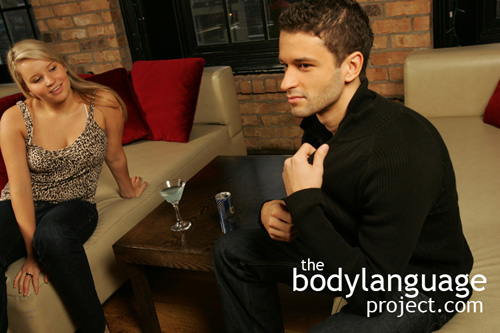Body Language of Masked Arm Cross
Synonym(s): Playing With The Cufflink, Playing With The Watch, Cufflink Adjust Language, Watch Play, Bracelet Play, Playing With A Button, Checking A Purse, Security Blankets.
Description: “The hand crosses the midline of the body and plays with the watch, bracelet or cufflink.”
In One Sentence: The masked arm cross signals insecurity and nervousness.
How To Use it: The masked arm cross is a way that we can create a barrier between us and other people. This is useful when we feel uneasy and need security. In front of large audiences playing with a wrist watch may help us feel more comfortable by giving us something to play with while at the same time, give us a barrier to hid behind. To appear confident, however, this body language should be avoided. In most cases, though, it generally goes unnoticed by most people.
Context: General.
Verbal Translation: “I’m feeling awkward, insecure, unsure, or nervous, so I’m playing with my watch or bracelet. This is a way I can cross and block off the mid-point of my body without being obvious or rude. I’m masking my negativity and insecurity.”
Variant: A person may use a cup of coffee held across the chest or a handbag placed on the lap to create a barrier by which comfort may be created. The coffee cup held chest high or across the other side of the body while seated serves as a partial arm cross. The handbag placed on the lap serves a protective purposed as it acts like a childhood blanket. See Coffee Cup Barrier or Handbag Barrier.
Cue In Action: a) Charles made his way through the adoring crowd while playing with his cufflink. The cufflink gave him something to do but also cut off access to his midbody similar to arm crossing. b) Bob habitually clasped his watch band and rotated it around his wrist.
Meaning and/or Motivation: Masked arm crossing implies that a person feels insecure or awkward, self conscious, nervous, timid, and desires security from a less exposed torso but feels that a full arm cross would be unacceptable due to it’s overt nature. The masked arm cross forms a loose loop rather than a tight loop as in the full arm cross.
Masked arm crossing is defined as ‘leaked.’ This is because the person is trying to prevent it from happening. However, their conscious mind is only successful at blocking a more obvious gesture, by replacing it with one that is slightly less pronounced.
The gestures are also considered “masked arm crosses” because they create a barrier-effect protecting the body.
Playing with the cuff link is a common choice for men attending formal affairs because it gives their hands a task to perform rather than simply dangling them awkwardly. Next time you see a televised awards show watch carefully as a presenter or an award winner makes his way up to the stage, he just might show his awkwardness by fingering his cufflink or watch.
Other forms of gestures that fall in the same family include holding or clutching a bag, checking the contents of a bag or briefcase, playing with a bracelet, watch or shirt button and holding a drink with one or both hands across the mid-point of the body. Any sort of motion that allows one hand or arm to cross the centre of the body, or where a crutch object is sought that otherwise serves little or no appropriate purpose, qualifies as a security blanket. To those aware of the cue, it is a very easy ‘tell’ to catch, because there really is no purpose for the behaviour aside from tension relief.
Cue Cluster: Watch for other signals of insecurity such as blushing, head lowered, a loss for words, shoulders shrugged, and so forth.
Body Language Category: Body cross, Disguised gestures, Displacement behaviour, Low confidence body language, Nervous body language.
Resources:
Balzarotti, Stefania ; Piccini, Luca ; Andreoni, Giuseppe ; Ciceri, Rita “I Know That You Know How I Feel”: Behavioral and Physiological Signals Demonstrate Emotional Attunement While Interacting with a Computer Simulating Emotional Intelligence. Journal of Nonverbal Behavior. 2014. 38(3): 283-299.
Bernstein, Constance. Winning trials nonverbally: six ways to establish control in the courtroom. Trial. 1994. 30(1).61(5)
Brownell, Judi. Communicating with credibility: The gender gap. Cornell Hotel and Restaurant Administration Quarterly. 1993. 34(2): 52-61.
Cacioppo, J. T., Priester, J. R., & Berntson, G. G. (1993). Rudimentary determinants of attitudes: II. Arm flexion and extension have differential effects on attitudes. Journal of Personality and Social Psychology, 65, 5–17.
DeSteno, D.; Breazeal, C.; Frank, R. H.; Pizarro, D.; Baumann, J.; Dickens, L, and Lee, J. Detecting the Trustworthiness of Novel Partners in Economic Exchange. Psychological Science. 2012. 23, 1549-1556.
http://bodylanguageproject.com/articles/use-body-language-cues-create-trust
Friedman, Ron and Andrew J. Elliot. The Effect Of Arm Crossing On Persistence And Performance. European Journal of Social Psychology. 2008; 38, 449–461 (2008). http://bodylanguageproject.com/articles/arm-crossing-effect-on-persistence-and-performance/
Fo¨rster, J. (2004). How body feedback influences consumer’s evaluation of products. Journal of Consumer Psychology, 14, 415–425.
Friedman, R. S., & Fo¨rster, J. (2000). The effects of approach and avoidance motor actions on the elements of creative insight. Journal of Personality and Social Psychology, 79, 477–492.
Gregersen, Tammy S. Nonverbal Cues: Clues to the Detection of Foreign Language Anxiety. Foreign Language Annals. 2005. 38(3): 388-400
http://bodylanguageproject.com/articles/what-anxious-learners-can-tell-us-about-anxious-body-language-how-to-read-nonverbal-behavior/
Gorkan Ahmetoglu, Viren Swami. Do Women Prefer “Nice Guys?” The Effect Of Male Dominance Behavior On Women’s Ratings. Social Behavior And Personality, 2012; 40(4), 667-672.
http://bodylanguageproject.com/articles/how-to-significantly-increase-male-attractiveness-with-simple-body-language-nice-guys-finish-last-once-again/
Hall, Jeffrey A. and Chong Xing. The Verbal and Nonverbal Correlates of the Five Flirting Styles. Journal of Nonverbal Behavior. 2015. 39:41–68. DOI 10.1007/s10919-014-0199-8
http://bodylanguageproject.com/articles/first-12-minutes-flirting-using-nonverbal-communication-study-reveals-26-body-language-cues-attraction/
Hung, Iris W. and Aparna A. Labroo. From Firm Muscles to Firm Willpower: Understanding the Role of Embodied Cognition in Self-Regulation. Journal of Consumer Research. 2011 37(6): 1046-1064.
http://bodylanguageproject.com/articles/firm-muscles-lead-willpower/
Johnson, Richard R. and Jasmine L. Aaron. Adults’ Beliefs Regarding Nonverbal Cues Predictive of Violence. Criminal Justice and Behavior. 2013. 40 (8): 881-894. DOI: 10.1177/0093854813475347.
http://bodylanguageproject.com/articles/wanna-fight-nonverbal-cues-believed-indicate-violence
Johnson, Richard R. and Jasmine L. Aaron. Adults’ Beliefs Regarding Nonverbal Cues Predictive of Violence. Criminal Justice and Behavior. 2013. 40 (8): 881-894. DOI: 10.1177/0093854813475347.
http://bodylanguageproject.com/articles/wanna-fight-nonverbal-cues-believed-indicate-violence/
Koppensteiner, Markus ; Grammer, Karl. Body movements of male and female speakers and their influence on perceptions of personality. Personality and Individual Differences. 2011. 51(6): 743-747.
Koppensteiner, Markus ; Stephan, Pia ; Jäschke, Johannes Paul Michael. From body motion to cheers: Speakers’ body movements as predictors of applause. Personality and Individual Differences. 2015. 74: 182-185.
Krauss, R. M., Dushay, R.A., Chen,Y., & Rauscher, F.(1995).The communicative value of conversational hand gesture. Journal of Experimental Social Psychology, 31(6), 533–552.
Laird, J. D., Wagener, J. J., Halal, M., & Szegda, M. (1982). Remembering what you feel: Effects of emotion on memory. Journal of Personality and Social Psychology, 42, 646–657.
Lee Ann Renninger, T. Joel Wade, Karl Grammer. Getting that female glance: Patterns and consequences of male nonverbal behavior in courtship contexts. Evolution and Human Behavior. 2004; 25: 416–431.
http://bodylanguageproject.com/articles/part-i-how-to-read-male-sexual-body-language-a-study-for-women-and-the-men-who-wish-to-cheat-the-system/
Leigh, Thomas W. ; Summers, John O. An initial evaluation of industrial buyers’ impressions of salespersons’ nonverbal cues. Journal of Personal Selling & Sales Management. 2002. 22(1): 41(13).
Mehrabian, Albert ; Williams, Martin Mcguire, William J. (editor). Nonverbal concomitants of perceived and intended persuasiveness. Journal of Personality and Social Psychology. 1969. 13(1): 37-58.
Marsh, Abigail A; Henry H. Yu; Julia C. Schechter and R. J. R. Blair. Larger than Life: Humans’ Nonverbal Status Cues Alter Perceived Size. PLoS ONE. 2009. 4(5): e5707. doi:10.1371/journal.pone.0005707. http://bodylanguageproject.com/articles/large-life-nonverbal-dominance-affects-perception-size/
Navarro, Joe. 2008. What Every BODY is Saying: An Ex-FBI Agent’s Guide to Speed-Reading People. William Morrow Paperbacks.
Neumann, R., & Strack, F. (2000). Approach and avoidance: The influence of proprioceptive and exteroceptive cues on encoding of affective information. Journal of Personality and Social Psychology, 79, 39–48.
Roll, William V. ; Schmidt, Lyle D. ; Kaul, Theodore J. Berdie, Ralph F. (editor). Perceived interviewer trustworthiness among black and white convicts. Journal of Counseling Psychology. 1972. 19(6): 537-541.
Ryan, Mary E. Good nonverbal communication skills can reduce stress. (Law Office Management). Trial. 1995. 31(1): 70(5).
Rule, Nicholas, O.; Reginald B. Adams Jr.; Nalini Ambady and Jonathan B. Freeman. Perceptions Of Dominance Following Glimpses Of Faces And Bodies. Perception. 2012; 41: 687-706 doi:10.1068/p7023
http://bodylanguageproject.com/articles/people-can-read-dominance-split-second
Riskind, J. H., & Gotay, C. C. (1982). Physical posture: Could it have regulatory or feedback effects upon motivation and emotion? Motivation and Emotion, 6, 273–296.
Schubert, Thomas W. The Power In Your Hand: Gender Differences In Bodily Feedback
From Making a Fist. Society for Personality and Social Psychology. 2004. 30(6): 757-769. DOI: 10.1177/0146167204263780
http://bodylanguageproject.com/articles/men-view-power-body-language-different-women-bodily-feedback-making-fist/
Schubert, Thomas W. and Sander L. Koole. The Embodied Self: Making A Fist Enhances Men’s Power-Related Self-Conceptions. Journal of Experimental Social Psychology. 2009; 45: 828–834.
http://bodylanguageproject.com/articles/the-power-of-a-balled-fist-making-a-fist-makes-men-feel-more-powerful/
Sharpley, Christopher F ; Halat, Jennifer ; Rabinowicz, Tammy ; Weiland, Birgit ; Stafford, Jane. Standard posture, postural mirroring and client-perceived rapport. Counselling Psychology Quarterly. 2001. 14(4): 267-280.
Stepper, S., & Strack, F. (1993). Proprioceptive determinants of emotional and nonemotional feelings. Journal of Personality and Social Psychology, 64, 211–220.
Tamir, M., Robinson, M. D., Clore, G. L., Martin, L. L., & Whitaker, D. J. (2004). Are we puppets on a string? The contextual meaning of unconscious expressive cues. Personality and Social Psychology Bulletin, 30, 237–249.
Teixeira Fiquer, Juliana; Paulo Sérgio Boggio and Clarice Gorenstein. Talking Bodies: Nonverbal Behavior in the Assessment of Depression Severity. Journal of Affective Disorders. 2013. 150: 1114-1119.
http://bodylanguageproject.com/articles/using-nonverbal-behaviour-to-assess-depression-severity/
Tiziano Furlanetto; Alberto Gallace; Caterina Ansuini and Cristina Becchio. Effects of Arm Crossing on Spatial Perspective-Taking. PLoS ONE 9(4): e95748. 2014. DOI: 10.1371/journal.pone.0095748
http://bodylanguageproject.com/articles/arm-crossing-makes-difficult-take-perspective/
Wu, Y. C., & Coulson, S.(2005).Meaningful gestures: Electrophysiological indices of iconic gesture comprehension. Psychophysiology, 42, 654–667.
Yuksel, Atila. Nonverbal Service Behavior and Customer’s Affective Assessment. Journal of Quality Assurance in Hospitality & Tourism. 2008. 9(1): 57-77.






